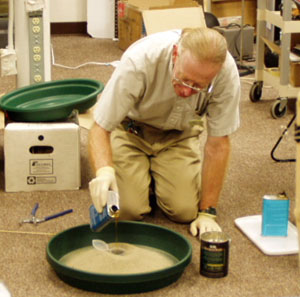Escaping gas is an important part of volcanic eruptions
Escaping gas is an important part of volcanic eruptions
Material
Assembly
Make a mound of sand in the center of the plant tray
Keep some sand to add to the top later.
Dig a hole in the center of the mound and insert the empty cup.
To Do and Notice

Pour in equal parts of the two components of the foam making mix.
Stir it for about a minute with the stirring stick.
Before it starts to foam, pour sand over the top of the cup.
Notice that at first nothing happens.
Then the foamy fluid breaks through the sand and an eruption begins.
At first the foam contains small bubbles and is very fluid, it flows down the sandy slopes of the volcano.
Then more bubbles appear and the mix becomes more viscous. The first flow may become thick enough to deflect later flows to the side.
As the flow becomes thicker it may plug the original hole forcing the liquid to push through a new hole.
Eventually the eruption slowly comes to a stop.
After a few minutes the foam becomes stiff and sticky, after a half hour the foam becomes hard and after a day it is fully cured.
The hard foam will snap off the plant tray.
The sand can be reused.
What's Going On?
The reaction of the two parts of the urethane foam making solution creates gas bubbles (full of water vapor). The gas is released continuously creating larger and larger bubbles. The foam eventually hardens.
Magma contains dissolved gas. When the magma gets near the surface the pressure on the magma is reduced the gas comes out of solution creating air bubbles that expand. These expanding air bubbles drive the magma out of the ground.
So What?
Many lavas contain gas bubbles, called vesicles.
Some pumice contains so many gas bubbles that it floats. It's amazing to see a lake with rocks floating on the surface.
When the pressure on a magma chamber is suddenly released as it was by a landslide on Mt St., Helens, the growth of gas bubbles can be explosive. The resulting expansion drives a huge amount of lava into the air creating and explosive eruption.
|
Scientific Explorations with Paul Doherty |
|
6 August 2002 |